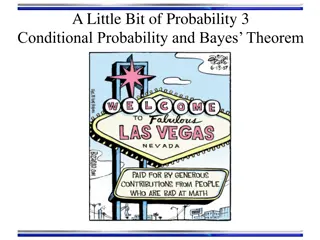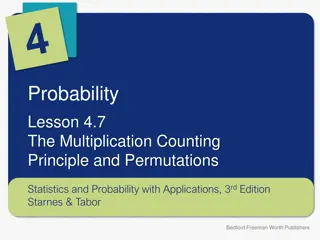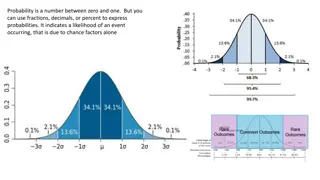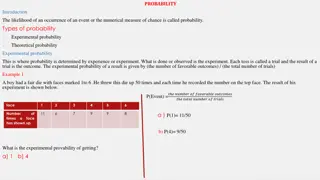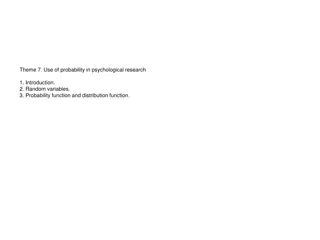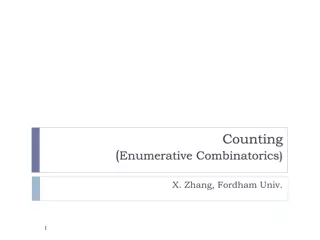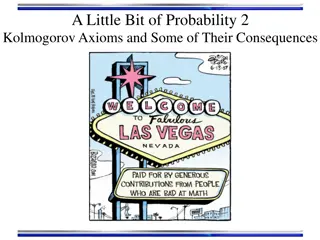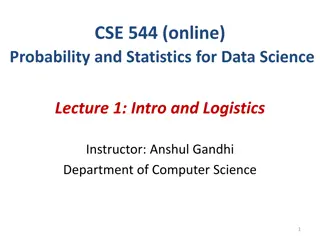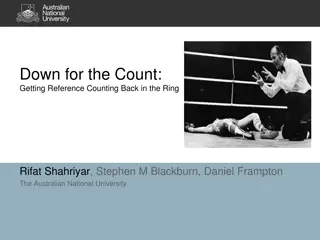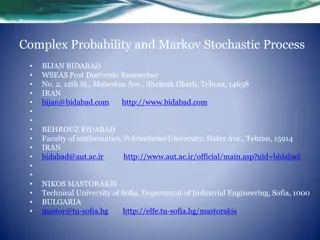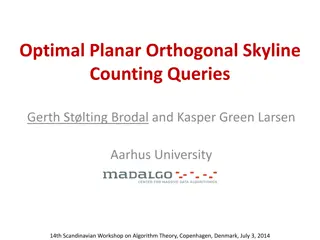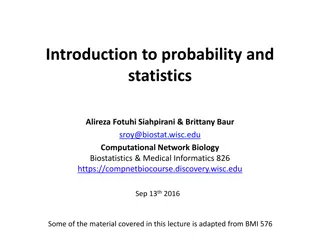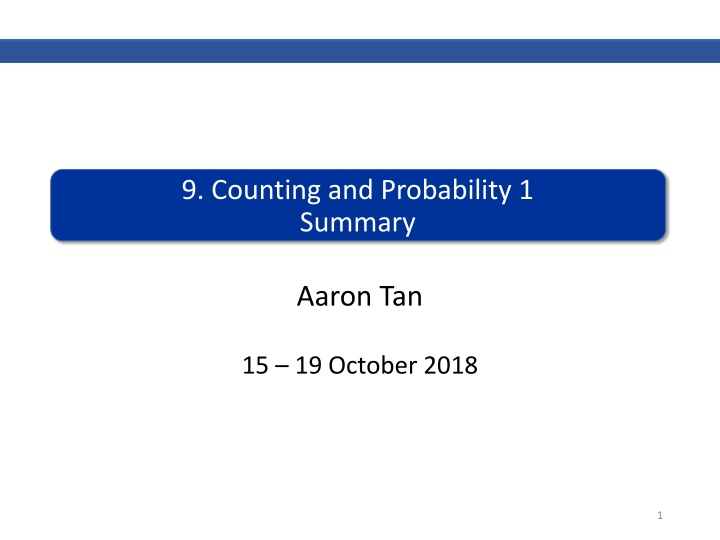
Counting and Probability Basics: Summary and Theorems
Discover the fundamental concepts of counting and probability in this summary, covering sample spaces, events, probability calculations, permutations, addition and difference rules, and more. Enhance your understanding of these essential principles to excel in your mathematical endeavors.
Download Presentation

Please find below an Image/Link to download the presentation.
The content on the website is provided AS IS for your information and personal use only. It may not be sold, licensed, or shared on other websites without obtaining consent from the author. If you encounter any issues during the download, it is possible that the publisher has removed the file from their server.
You are allowed to download the files provided on this website for personal or commercial use, subject to the condition that they are used lawfully. All files are the property of their respective owners.
The content on the website is provided AS IS for your information and personal use only. It may not be sold, licensed, or shared on other websites without obtaining consent from the author.
E N D
Presentation Transcript
9. Counting and Probability 1 Summary Aaron Tan 15 19 October 2018 1
Summary 9. Counting and Probability 1 9.1 Introduction Random process, sample space, event and probability 9.2 Possibility Trees and the Multiplication Rule Possibility trees The multiplication rule Permutations 9.3 Counting Elements of Disjoint Sets The addition rule The difference rule The inclusion/exclusion rule 9.4 The Pigeonhole Principle Pigeonhole principle, general pigeonhole principle 2
Summary 9.1 Introduction Definition A sample space is the set of all possible outcomes of a random process or experiment. An event is a subset of a sample space. Notation For a finite set A, N(A) denotes the number of elements in A. Equally Likely Probability Formula If S is a finite sample space in which all outcomes are equally likely and E is an event in S, then the probability of E, denoted P(E), is The number of outcomes in E The total number of outcomes in S N(E) N(S) P(E) = = Theorem 9.1.1 The Number of Elements in a List If m and n are integers and m n, then there are n m + 1 integers from m to n inclusive. 3
Summary 9.2 Possibility Trees and Multiplication Rule Theorem 9.2.1 The Multiplication Rule If an operation consists of k steps and the first step can be performed in n1 ways, the second step can be performed in n2 ways (regardless of how the first step was performed), : the kth step can be performed in nk ways (regardless of how the preceding steps were performed), Then the entire operation can be performed in n1 n2 n3 nkways. 4
Summary 9.2 Possibility Trees and Multiplication Rule Theorem 9.2.2 Permutations The number of permutations of a set with n (n 1) elements is n! Definition An r-permutation of a set of n elements is an ordered selection of r elements taken from the set. The number of r-permutations of a set of n elements is denoted P(n, r). Theorem 9.2.3 r-permutations from a set of n elements If n and r are integers and 1 r n, then the number of r-permutations of a set of n elements is given by the formula P(n, r) = n(n 1)(n 2) (n r + 1) first version or, equivalently, n! P(n, r) = second version (n r)! 5
Summary 9.3 Counting Elements of Disjoint Sets Theorem 9.3.1 The Addition Rule Suppose a finite set A equals the union of k distinct mutually disjoint subsets A1, A2, , Ak. Then N(A) = N(A1) + N(A2) + + N(Ak). Theorem 9.3.2 The Difference Rule If A is a finite set and B is a subset of A, then N(A B) = N(A) N(B). Formula for the Probability of the Complement of an Event If S is a finite sample space and A is an event in S, then P(Ac) = 1 P(A). Theorem 9.3.3 The Inclusion/Exclusion Rule for 2 or 3 Sets If A, B, and C are any finite sets, then N(A B) = N(A) + N(B) N(A B) and N(A B C) = N(A) + N(B) + N(C) N(A B) N(A C) N(B C) + N(A B C). 6
Summary 9.4 The Pigeonhole Principle Pigeonhole Principle A function from one finite set to a smaller finite set cannot be one-to-one: There must be at least 2 elements in the domain that have the same image in the co-domain. Generalized Pigeonhole Principle For any function f from a finite set X with n elements to a finite set Y with m elements and for any positive integer k, if k < n/m, then there is some y Y such that y is the image of at least k + 1 distinct elements of X. Generalized Pigeonhole Principle (Contrapositive Form) For any function f from a finite set X with n elements to a finite set Y with m elements and for any positive integer k, if for each y Y, f 1(y) has at most k elements, then X has at most km elements; in other words, n km. 7
Summary 9.4 The Pigeonhole Principle Definition: Onto Function Definition: One-to-One Function Let F be a function from a set X to a set Y. F is one-to-one (or injective) iff for all elements x1 and x2 in X, if F(x1) = F(x2), then x1 = x2, or, equivalently, if x1 x2, then F(x1) F(x2). Let F be a function from a set X to a set Y. F is onto (or surjective) iff given any element y in Y, it is possible to find an element x in X such that y = F(x). Theorem 9.4.1 The Pigeonhole Principle For any function f from a finite set X with n elements to a finite set Y with m elements, if n > m, then f is not one-to-one. Theorem 9.4.2 One-to-One and Onto for Finite Sets Let X and Y be finite sets with the same number of elements and suppose f is a function from X to Y. Then f is one-to-one if, and only if, f is onto. 8




